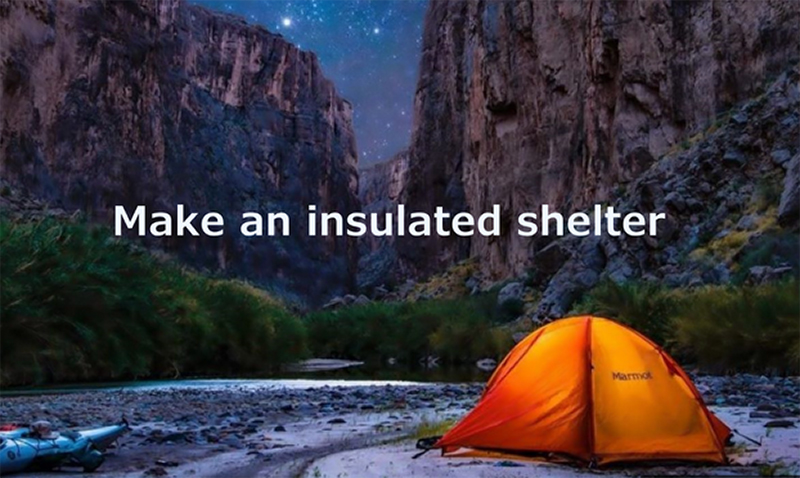Top 10 Survival Tips. How to survive in wilderness situation.
You’re in a wilderness situation that’s less than ideal — and you want to get back to safety. Do you have the skills to protect yourself from harm?
Below are the top 10 survival tips that every outdoors person should know:
Master your attitude
In any survival situation, the most important thing is to remain calm and avoid panicking. Maintaining a positive, proactive attitude makes you more likely to survive a difficult situation. Panicking makes the things worse.
- Develop a plan.
- Inventory the resources you have.
- Determination: Often, grit separates a survivor from a non-survivor.
- Identify the essential tasks necessary for survival, such as obtaining water, shelter, and warmth.
- Recognize feelings are not facts. You may feel hopeless, but focus on the tasks that must be accomplished.
Make an insulated shelter
Building an effective shelter can help protect you from hypothermia — and the elements.
- Think small: Since your body heat will be your primary source of warmth, build a shelter just enough to accommodate your body when lying down.
- Construct the framework: To make a simple lean-to, use available resources, such as a fallen tree or rest a strong branch securely against a standing tree.
- Add the sides: Stack sticks close together on one side. Use progressively smaller sticks to fill in gaps.
- Add insulation: Cover the sides with bark, leaves, pine needles, moss, etc. — the thicker the material, the more protected you will be. Add similar insulation to the ground, the thicker, the better.
Make a shade shelter
In some situations, protection from heat will matter most.
- Think cool: Digging just a few inches in the soil can uncover cooler ground.
- Build a lean-to: Use sticks or limbs to make a shelter over the exposed ground.
- Remain cool: Lie in the cool soil beneath the shade.
- Let the air flow: The purpose of this shelter is to create shade. Use available materials such as bark, leaves, a poncho, an emergency sleeping bag or blanket, or any available fabric to cover one side.
Find clean water
Finding clean, uncontaminated water is the holy grail of survival.
- Rain: Collect, store, and drink.
- Snow: The energy required for your body to absorb the water from snow is high. Melting it first can easily be done over a campfire or camp stove. If those aren’t options, use the sun. Accelerate the process by chopping ice and hanging it in a water bag in direct sunlight. If there’s no sun, use your body’s heat.
Find other water sources
Boiling water for a minute is the best and safest way to kill off any pathogens.
- Digging for water: Certain plants indicate water sources are nearby. Identify plants, such as cattails, cottonwood, or willows, and dig a seep hole until you reach moisture. Wait for the water to collect in the spot.
- Think topographically: Rock outcroppings or indentations are likely areas for water to accumulate. Remember, water found in puddles or streams should be boiled.
- Collect water from vegetation
- Dew: Dew collects on plants and grasses. Soak up the dew and then squeeze it into a container using a cloth or piece of clothing. This can be a very effective method of collecting a considerable amount of water.
- Plant Moisture Bag: Just like humans, plants sweat. Tie a plastic bag around a leafy branch of a tree, and over time, water will collect.
Light a fire
You’ll want to practice alternative fire methods starting before they are needed.
- Easy: Use lighter or waterproof matches. Keep your matches dry in a waterproof container.
- Medium: Use a magnesium fire starter. Shave magnesium filings off the stick, use the back of your knife to create a spark, and ignite the filings.
- Advanced: A battery can create a spark to light tinder. Use your vehicle battery (removed from the vehicle or boat) by attaching wires or steel wool to connect the positive and negative posts. This will induce a spark or ignite the wool. With smaller batteries, align two batteries together, positive to negative. Use strands of steel wool to connect the posts to create a spark and ignite the wool. A 9-volt battery works great.
Build a fire
- Create a tinder bundle: Gather pine needles, dry leaves, milkweed, or thistle down and dry grass for tinder.
- Start small: Gather small, dry sticks for kindling.
- Go big: Find larger pieces of wood for long-burning fuel.
- Put it together: Create a nest out of the tinder using a larger piece of wood as a wind block. Create a tipi out of smaller kindling so oxygen can get in. Ignite the tinder and place it under the tepee. Use long, steady breaths to spread the flame. As the smaller pieces catch, add progressively larger fuel to the fire.
Keep Right Ammunition for Wilderness Survival
Whether you're protecting yourself from predators or hunting for food, the type of ammo you carry can make a significant difference. Popular choices include 9mm ammo and 45 ACP ammo, both known for their reliability and effectiveness. The 9mm is favored for its lighter recoil and higher capacity, making it a versatile option for self-defense. On the other hand, the .45 ACP offers more stopping power, which can be crucial in close encounters with larger animals.
Know these knots
All outdoors people should know a variety of knots. When it comes to survival, ensure you have these two ready.
- Bowline: The bowline knot is a highly practical knot commonly used to create a secure loop when attaching an object to a rope. This knot is particularly useful because the more tension is applied, the more tightly it grips the thing. To tie the bowline knot, create a loop with the rope and follow this simple phrase to remember the steps: "The rabbit comes out of the hole, goes around the tree, and back down the hole again." Following these steps will create a secure and reliable knot that will hold your object in place.
- Double half hitch: Attach one rope's end around an object. This is a useful knot for building a shelter. Tie a half hitch around your object, like a tree or pole, and follow it by a second in the same direction to make it a double. Pull tight to make it secure.
Make a spear
With a simple spear, you can improve your odds of catching a fish or other small game.
- Select a long, straight stick.
- Split the end of the stick to create a fork.
- Separate the fork with a wooden wedge or small stone. Lash it into place.
- Sharpen each fork with a knife or sharp rock.
To make a triple-prong spear, add a smaller stick after placing the wedge, sharpen, and lash it into place.
5 pieces of gear to have
When it comes to survival gear, tools that can serve more than one purpose are best.
- Lighter: Bic ($4); Coghlan’s Magnesium Starter ($7.99) for backup; tea light candle ($1) — A lighter is cheap and stays dry to light tinder. Having a backup fire starter is essential.
- Cell phone: Though you might not always get a signal, it has become an essential modern survival tool. Carry an extra battery or an external charger as well.
- Hydration bag: MSR Dromedary Bag 10-L ($44.95) — Though the MSR Dromedary hydration bag comes in several sizes, going with the 10-L allows you to the flexibility to vary your volume, depending on your current need. What sets this bag apart from others is its tough outer shell, which protects against abrasions and leakage.
- Folding knife: The TecX Inceptra Fold-Up Knife ($24.99) is secure and sharp. This inexpensive fold-up knife is lightweight and conveniently folds for safety. Also, it easily shaves wood for kindling or serves as a spear point.
- Emergency shelter: Adventure Medical Kits’ S.O.L. Thermal Bivvy ($29) is lightweight and compact. This waterproof thermal sack will help you retain your body heat and avoid skin exposure to cold air.


